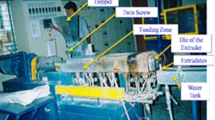Abstract
Thermoplastic polyurethane (TPU) and isotactic polypropylene (iPP) composites and their talc reinforced blends containing untreated and silane treated talc were investigated. The talc surface was modified with organosilane coupling agent in order to improve the polymer–filler interface interaction. TPU has been blended with iPP in a twin screw extruder and samples for investigation were prepared by injection moulding at different concentrations. The neat polymers, composites and blends were characterized with DMA, XRD, FTIR and tensile testing. The obtained results showed that mechanical properties of the talc filled TPU and iPP composites and TPU/iPP blends were improved with the addition of untreated and silane treated talc. The storage modulus of the TPU/iPP blends increased with the addition of untreated and silane treated talc, due to a stiffer interface which talc generated in the polymer matrix. The comparison among samples filled with untreated and silane treated talc filler showed that the polymer composites and TPU/iPP blends filled with silane treated talc displayed better mechanical properties. Silane addition improves the adhesion between the filler and the polymer matrix.







Similar content being viewed by others
References
Kamble A, Singh V, Thomas M, John N (2011) Effectiveness of compatibilizers and filler on the performance of the blends of thermoplastic polyurethane/polyolefins. Chem Sci J 34:1–9
Fujiyama M, Wakino T (1991) Crystal orientation in injection molding of talc filled polypropylene. J Appl Polym Sci 42:9–20. doi:10.1002/app.1991.070420103
Leong YW, Bakar MB, Ariffin A (2005) Effects of filler treatments on the mechanical, flow, thermal, and morphological properties of talc and calcium carbonate filled polypropylene hybrid composites. J Appl Polym Sci 98(1):413–426. doi:10.1002/app.21507
Khunová V, Hurst J, Janigová I, Smatko V (1999) Plasma treatment of particulate polymer composites for analyses by scanning electron microscopy: II. A study of highly filled polypropylene/calcium carbonates composites. Polym Test 18:501–509. doi:10.1016/S0142-9418(98)00038-5
Fujiyama M, Wakino T (1991) Structures and properties of injection moldings of crystallization nucleator-added polypropylenes. I. Structure–property relationships. J Appl Polym Sci 42:2739–2747. doi:10.1002/app.1991.070421012
Dıez-Gutiérrez S, Rodrıguez-Pérez MA, De Saja JA, Velasco JI (1999) Dynamic mechanical analysis of injection-moulded discs of polypropylene and untreated and silane-treated talc-filled polypropylene composites. Polymer 40:5345–5353. doi:10.1016/S0032-3861(98)00754-X
Zoltan D, Pukanszky B, Nagy J Jr (1999) Possible coupling reactions of functional silanes and polypropylene. Polymer 40:1763–1773. doi:10.1016/S0032-3861(98)00396-6
Metın D, Tihminlioğlu F, Balköse D, Ülkü S (2004) The effect of interfacial interactions on the mechanical properties of polypropylene/natural zeolite composites. Compos Part A Appl Sci Manuf 35(1):23–32. doi:10.1016/j.compositesa.2003.09.021
Jesionowski T, Krysztafkiewicz A (2000) Comparison of the techniques used to modify amorphous hydrated silicas. J Non-Crystall Solids 277:45–57. doi:10.1016/S0022-3093(00)00299-4
Ogasawara T, Yoshino A, Okabayashi H, O’Connor CJ (2001) Polymerization process of the silane coupling agent 3-aminopropyltriethoxy silane-1 H NMR spectra and kinetics of ethanol release. Collo Surf A Physicochem Eng Asp 180:317–322. doi:10.1016/S0927-7757(00)00813-X
Govorčin Bajsić E, Ocelić Bulatović V, Rek V (2015) The influence of filler treatment on the properties of TPU/PP blends: I. Thermal properties and stability. Polym Eng Sci 55:1920–1930. doi:10.1002/pen.24033
Trotignon JP, Tcharkhtchi A (1996) Fatigue behaviour of filled polymers. Macromol Symp 108:231–245. doi:10.1002/masy.19961080119
Jančář J, Dibenedetto AT, Dianselmo A (1996) Engineered interphases in particulate filled polypropylene. Chem Pap 50:228–232. 504a228.pdf
Stamhuis JE (1984) Mechanical properties and morphology of polypropylene composites. Talc filled elastomer modified polypropylene. Polym Comp 5:202–207. doi:10.1002/pc.750050308
Velasco JI, De Saja JA, Martinez AB (1996) Crystallization behavior of polypropylene filled with surface modified talc. J Appl Polym Sci 61:125–132. doi:10.1002/(SICI)1097-4628(19960705)61:1<125:AID-APP14>3.0.CO;2-6
Ray SS, Bandyopadhyay J, Bousmina M (2008) Influence of degree of intercalation on the crystal growth kinetics of poly [(butylene succinate)-co-adipate] nanocomposites. Eur Polym J 44:3133–3145. doi:10.1016/j.eurpolymj.2008.07.035
Pustak A, Pucić I, Denac M, Švab I, Pohleven J, Musil V, Šmit I (2013) Morphology of polypropylene/silica nano- and microcomposites. J Appl Polym Sci 128:3099–3106. doi:10.1002/app.38487
Wu S (1985) Phase structure and adhesion in polymer blends: a criterion for rubber toughening. Polymer 26:1855–1863. doi:10.1016/0032-3861(85)90015-1
Kalfus J, Jancar J (2007) Elastic response of nanocomposite poly(vinylacetate)-hydroxyapatite with varying particle shape. Polym Compos 28:365–371. doi:10.1002/pc.20273
Hoyle CE, Kim KJ, No YG, Nelson GL (1987) Photolysis of segmented polyurethanes. The role of hard segment content and hydrogen bonding. J Appl Polym Sci 34:763–774. doi:10.1002/app.1987.070340227
Dillon JG (1989) Infrared spectroscopic atlas of polyurethanes (including model compounds). Technomic Publ. Co., Lancester
Seymour RW, Estes GM, Cooper SL (1970) Infrared studies of segmented polyurethan elastomers. I. Hydrogen bonding. Macromolecules 3:579–583. doi:10.1021/ma60017a021
Silverstein RM, Webster FX, Klemie DJ (2005) Spectrometric identification of organic compounds, 7th edn. Wiley, New York
Coleman MN, Lee KH, Skrovanek DJ, Painter PC (1986) Hydrogen bonding in polymers. 4. Infrared temperature studies of a simple polyurethane. Macromolecules 19:2149–2157. doi:10.1021/ma00162a008
Srichatrapimuk VW, Cooper SL (1978) Infrared thermal analysis of polyurethane block polymers. J Macromol Sci Part B Phys 15:267–311. doi:10.1080/00222347808212599
Tadokoro H, Kobayashi M, Ukita M, Yasufuku K, Murahashi S (1965) Normal vibrations of the polymer molecules of helical conformation. V. Isotactic polypropylene and its deuteroderivatives. J Chem Phys 42:1432–1449. doi:10.1063/1.1696134
Danec M, Šmit I, Musil V (2005) Polypropylene/talc/SEBS (SEBS-g-MA) composites. Part 1. Structure. Appl Sci Manuf 36:1094–1101. doi:10.1016/j.compositesa.2005.01.022
Acknowledgements
The authors gratefully acknowledge the financial support provided by the Ministry of Science, Education and Sport of the Republic of Croatia (Project No. 125-1252971-2578).
Author information
Authors and Affiliations
Corresponding author
Rights and permissions
About this article
Cite this article
Bajsić, E.G., Filipan, V., Bulatović, V.O. et al. The influence of filler treatment on the mechanical properties and phase behavior of thermoplastic polyurethane/polypropylene blends. Polym. Bull. 74, 2939–2955 (2017). https://doi.org/10.1007/s00289-016-1879-9
Received:
Revised:
Accepted:
Published:
Issue Date:
DOI: https://doi.org/10.1007/s00289-016-1879-9




